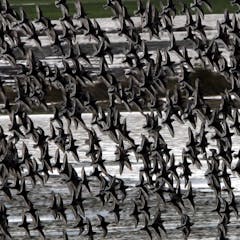
Articles on Moving the Masses
Displaying all articles

Marketers once liked to think they could virtually steer people through shops and malls. But it appears shoppers’ movements, possibly driven by primal instincts, aren’t so easily directed.

Collisions at intersections between motor vehicles, cyclists and pedestrians cause many deaths and injuries. Design that considers how each group approaches intersections improves everyone’s safety.

Everyone doesn’t simply wait their turn at traffic lights. Signals are set up to enable a ‘green wave’ for cars and adjust to heavy traffic, making walkers wait longer no matter how many there are.

By identifying and applying the key rules governing the behaviour of each individual, agent-based modelling offers insights into complex phenomena like traffic jams and flocking.

Insects aren’t known for having big brains, and slime moulds and fungi don’t have any. So how do they solve challenges that test the ingenuity of human transport engineers?

Businesses are weighing up the costs of queuing and using innovative ways to minimise these costs by doing away with queues.

Cities are expanding upwards and downwards, as well as outwards. With urban density also increasing, moving people efficiently around the city, often using ageing infrastructure, is quite a challenge.





